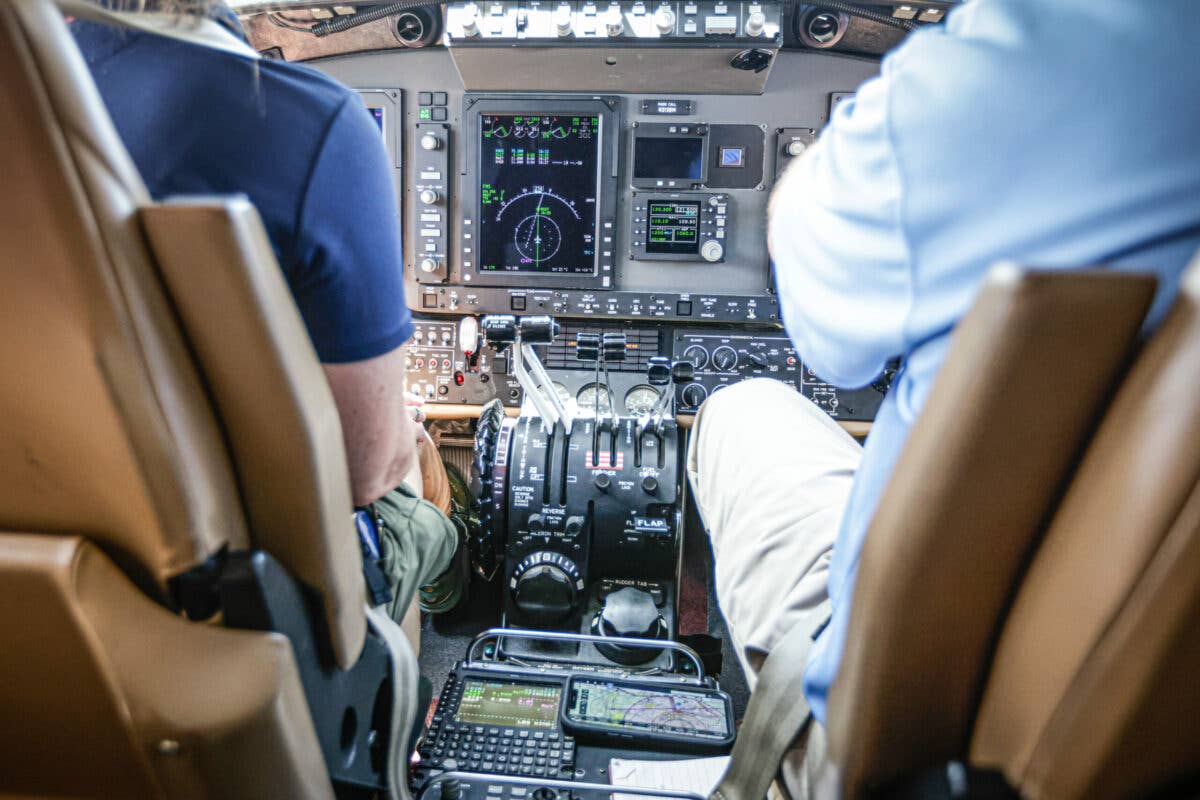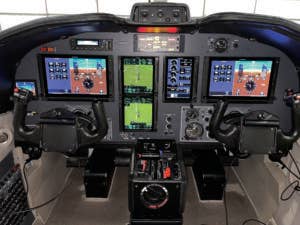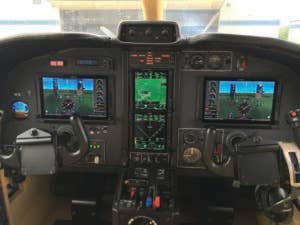Upgrades Offer New Life for Legacy Turboprops
Here are three upgrade options that can improve a turboprop’s safety, performance, and ease of operation.

The wide range of turboprops on the market reflect the penetration these aircraft have had in delivering utility to business applications as well as personal use.
[Credit: Stephen Yeates]
The wide range of turboprops on the market reflect the penetration these aircraft have had in delivering utility to business applications as well as personal use. If you'd like to upgrade a solid airplane and improve its safety, performance, and ease of operation, take a look at these three options for a meaningful update.
Innovative Solutions & Support ThrustSense Autothrottles for PC-12s and King Airs
Geoff Hedrick, the late founder of Innovative Solutions & Support (IS&S), used to fly a Pilatus PC-12 for business and personal travel. So it was natural that Hedrick would end up working closely with Pilatus Aircraft on integrating into the PC-12 the expertise developed by his company for commercial platforms like the Boeing 757 and 767. IS&S introduced the ThrustSense autothrottle to the series as an aftermarket add-on in 2017, and it became standard on the PC-12 NGX in 2019, paired with the FADEC-equipped Pratt & Whitney PT6E-67XP. Now, more than 30 PC-12s have been retrofitted with the system, according to Tom Grunbeck, director of autothrottle products for IS&S.
Following that success, IS&S set its sights on the Beechcraft King Air series, with the clear advantages that an autothrottle would give to the beefy twin turboprop when operated single-pilot—especially if one of its PT6As gave up the ghost.
Hedrick described the experience for the pilot in an interview with FLYING last year. “You’ll see things in the King Air, like throttle balancing automatically, so that when you set your throttle, you just push them up— the slow throttle comes up automatically,” he said. “No buttons, no pushes. It sits quietly behind you [even in manual mode], kind of like a flight engineer moving the throttles for you.” We flew with the ThrustSense system on both the company’s PC-12 and the King Air 200—and we can vouch for that “silent sentry” effect the system has in normal operations—and the ease with which it handles an “engine out in a climb” scenario.
The kit for the King Air includes a standby control unit, two actuators in series with engine control cables, and two circuit breakers to the breaker panel. The retrofit kit can be installed on King Airs with Pro Line 21 or Pro Line Fusion integrated flight decks. On new production King Air 260s and 360s, the autothrottle started at a block point change when Textron Aviation moved from the 350 series to the 360, Grunbeck says.
IS&S has proactively positioned itself to weather supply chain ups and downs by keeping six sets of its aftermarket ThrustSense autothrottle kits on the shelf at all times. They want to stay responsive to the demand from the turboprop niche that has discovered the utility—and safety benefit—of introducing an autothrottle’s capabilities. Turnaround time using IS&S’s mobile unit can be as short as five days, and the retrofit can also be accomplished at Textron service centers, as well as independent avionics shops. The company is also expanding into the Cessna Citation 525 series.
Tamarack Active Winglets for King Airs
The King Air series probably holds the crown for workhorse of the business aircraft fleet, with its flexibility on field length, passenger room, and load-carrying capability. So, what if you paired its range with the ability to milk slow-speed loitering for all it was worth? Then you would have a special mission airplane ranking high among a wide portfolio of customers, from the U.S. Air Force to the Drug Enforcement Administration.
Tamarack Aerospace has installed more than 160 sets of its load-alleviating active winglets on Cessna Citation 525-series jets, and the company reports a range improvement of up to 33 percent through that fleet. Now, it’s translating what it calls its “SmartWing” technology to the King Air series. Answering the call from companies that fulfill military contracts, Tamarack has developed its active winglet tech for King Airs, adding 23 percent improvement in endurance, 18 percent improvement in range, and a reduction in stall speed such that pilots can see takeoff and landing distances reduced by up to 15 percent.
We flew with the winglets installed on both the 200 and 300 series King Airs to observe them in action. For the 200, since Tamarack aims its product at the military and special ops, the company used a King Air C-12 variant of the 200 for flight testing. On the climb up to 17,000 feet msl, we maintained an indicated airspeed of 110 knots—below the blue line printed on the gauge— and a climb rate of more than 3,500 fpm sustained for a time to climb from near sea level of 6 minutes.
We performed a series of maneuvers to demonstrate the low-speed handling—and the winglets engaged to mitigate the effects of any turbulence we flew through. Stalls in the landing configuration led to an indicated airspeed of less than 55 knots on the dial. We went on to loiter at that same 110 knots and about 336 pph total, leading to about 7 hours of endurance—optimized for the mission. That translates to the ability to dispatch for a flight in which the lower fuel load and overall reduced takeoff weight can ensure the airplane is able to make any required single-engine climb gradients.
Nick Guida, founder and CEO of Tamarack, developed the original load-alleviating technology a little more than 10 years ago. He describes how the system works: “Typically, at really low lift coefficients, you’re not going to get a benefit from [normal] winglets because the induced drag [value] is much lower—so if you had low, low lift coefficients, most of the drag is from form drag rather than induced drag. But as you fly high coefficients, higher altitudes, lower indicated speeds… that’s where winglets really shine.


“At limit load, in really big gusts or maneuvers, it’s pushing down on the wing, but when you’re pulling Gs, the wing wants to go up,” Guida continues. “So, it’s counteracting the effect of a winglet, but in a very short period of time. A gust typically on this airplane is less than half a second, so for half a second they pop up, kill the load, and you don’t care about efficiency during that one-half a second cause that’s such a [short] occurrence. As soon as you go back to normal, you’re flying straight.”
The mod adds more than 4 feet of wing, per wing—9 feet total on the King Air. Tamarack is in the process of certifying the SmartWing system on the 200 and 350 models, in both civilian and military variants.
Garmin Digital Autopilot for TBMs
You might think the opportunity to trade analog gauges—like a creaky horizontal situation indicator (HSI) and yellowing attitude indicator—for glass primary and multifunction displays would be enough of a reason to consider upgrading a 700-series TBM from its original panel configuration to a Garmin suite. While the Silver Crown nav/com radios, KFC 275 autopilot, King EFIS 40 electronic HSI, and optional loran and RDS-81 weather radar made the panel state of the art at the time it debuted, we’ve come a long way, baby, since 1988.
But that’s not the real delighter to be found in the transition.
Actually, the word back from owners who have installed new avionics focuses on their satisfaction with the upgrade to the Garmin GFC 600 digital autopilot, according to Mike Sweeney, avionics specialist for Daher’s award-winning service team in Pompano Beach, Florida. “That’s what pilots are most impressed by,” Sweeney says. While it makes sense that the smoother coupled-approach modes, fly-by turns, and autosequencing during a go-around would top the list, there are other more quotidian features to the GFC 600 operating behind the scenes.
The brushless servos that drive mechanical inputs to the flight controls offer significantly more power, making for better control over the aircraft than the brush-motor servos in the legacy autopilots, such as the 275 and the then-upgrade, the KFC 325. The GFC 600 requires at least a Garmin G600 or G1000 TXi to couple with in order to gain the most, but a full panel of new glass is not necessary. Or, if the owner opts for a GTN 750 Xi, they can take advantage of new features like Smart Glide—a kind of “autoland lite” that acts as an assistant to the pilot in the event of a power loss.
We flew with the GFC 600 installed in a very early serial number TBM 700—and the smooth nature of the new system is unquestionable, readily complementing the fine handling characteristics and solid control feel of the sleek turboprop.
An installation of the autopilot alone can be accomplished for roughly $60,000. And while many products are on a four- to six-month backorder from Garmin at press time—supply chain woes continue—a wide range of shops can perform the work.
Another popular upgrade in the works, according to Sweeney? The Garmin GWX 8000 Doppler weather radar. “It has the same footprint as the [GWX] 75 it replaces,” he says. The high-def, four-color palette shines brightly in comparison to the legacy radars with their glowing green sweeps—providing detailed contouring of storms and automatic threat analysis.
There’s definitely a new life out there for the trusty turboprops that have carried us through the last 30, 40, 50 years.

Subscribe to Our Newsletter
Get the latest FLYING stories delivered directly to your inbox






